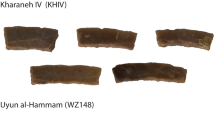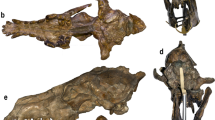Abstract
Most of the existing methods of strain analysis can estimate strain in a single form of distorted brachiopod, or trilobite provided independent evidence, such as the association of the fossil with cleavage and/or stretching lineation is available for inferring the direction of maximum principal strain. This article proposes a simple computer graphics based method and its MATLAB code that determine the minimum amount of strain in a single distorted fossil form even if data for inferring the maximum principal strain direction are lacking. Our method is a rapid computer-graphics alternative to some of the existing analytical methods.
In a distorted fossil form of original bilateral symmetry, the relative senses of angular shears along the hinge line and the median line are mutually opposite to each other. It follows, therefore, that the maximum principal strain direction lies within the acute angle between the hinge and the median lines in the plane of the fossil. Using this principle, our method performs several simulations such that each simulation retrodeforms the distorted fossil by assuming a particular orientation, lying within the acute angle between the hinge line and the median line, as the potential direction of the maximum principal strain. Each simulation of retrodeformation yields a potential strain ratio. The distribution of all the potential strain ratios, obtained by assuming different orientations as the potential directions of the maximum strain, is typically a parabola-like curve with a distinct vertex that corresponds to the minimum amount of strain in the distorted fossil. An entirely computer graphical approach is somewhat time-intensive because it involves a large number of retrodeformational simulations. We, therefore, give a MATLAB code, namely, the Minstrain, that rapidly retrodeforms the fossil and determines the minimum strain with precision.
Similar content being viewed by others
References
Breddin, H. (1956) Die tektonische Deformation der Fossilien im Rheinnischen Schiefergebirge. Zeitschrift Deutsche Geologische Gesellschaftm v.106, pp.227–305.
Cooper, R.A. (1990) Interpretation of tectonically deformed fossils. New Zealand Jour. Geol. Geophys. v.33, pp.321–333.
De Paor, D.G. (1986a) Orthographic analysis of geological structures II-Practical Application. Jour. Struc. Geol. v.8, pp.87–100.
De Paor, D.G. (1986b) Quantitative structural geology — a graphical approach. Jour. Geol. Edu. v.34, pp.87–100.
Engelder, T. and Engelder, R. (1977). Fossil distortion and decollement tectonics of the Appalachian Plateau. Geology v.5, pp.457–460.
Fank, A. (1929) Die bruchlose Deformation von fossilien durch tekonishen Druck und ihr Einfluss auf kie Bestimmung der Arten. Zurich, Dissonaz, 59p.
Haughton, S. (1856) On slaty cleavage and distortion of fossils. Philosophical Magz. v.12, pp.409–421.
Hughes, N.C. and Jell, P.A. (1992) A statistical/computer graphic technique for assessing variation in tectonically deformed fossils and its application to Cambrian trilobite from Kashmir. Lethaia v.25, pp.317–330.
Lake, P. (1943) Restoration of the original form of distorted specimens. Geol. Magz. v.80, pp.139–147.
Ramsay, J.G. (1967) Folding and fracturing of rocks. McGraw Hill, New York, 568p.
Ramsay, J.G. and Huber, M.I. (1983) The techniques of modern structural geology: volume 1: strain analysis. London, Academic Press, 307p.
Rushton, A.W.A. and Smith, M. (1993) Retrodeformation of fossils-A simple technique. Palaeontology v.36, pp.927–930.
Sdzuy, K. (1966) An improved method for analyzing distortion in fossils. Palaeontology v.9, pp.125–134.
Shah, J. (2007) New methods of strain analysis and deformation style in parts of Kumaun Lesser Himalaya. Unpublished Ph.D. thesis, IIT Roorkee, India, 258p.
Sharpe, J. (1847) On slaty cleavage. Quart. Jour. Geol. Soc. London v.3, pp.74–105.
Srivastava, D.C. and Shah, J. (2006) Digital method for strain estimation and retrodeformation of bilaterally symmetric fossils. Geology v.34, pp.593–596.
Valdiya, K.S. (1998) Dynamic Himalaya. University Press, Hyderabad, India, 178p.
Van Der Pluijm, B.A. and Marshak, S. (1997) Earth Structure, An introduction to structural geology and tectonics. WCB/McGraw-Hill, 495p.
Wellman, H.W. (1962) Graphical method for analyzing fossil distortion caused by tectonic deformation. Geological Magazine v.99, pp.348–352.
Zen, F.C., Coben, B. and Scfeng, C. (1952) Tectonics of the Appalachians: Thomas, Nelson and Sons Limited.
Author information
Authors and Affiliations
Corresponding author
Rights and permissions
About this article
Cite this article
Shah, J., Srivastava, D.C., Rastogi, V. et al. Strain estimation from single forms of distorted fossils — A computer graphics and MATLAB approach. J Geol Soc India 75, 89–97 (2010). https://doi.org/10.1007/s12594-010-0026-8
Received:
Accepted:
Published:
Issue Date:
DOI: https://doi.org/10.1007/s12594-010-0026-8




